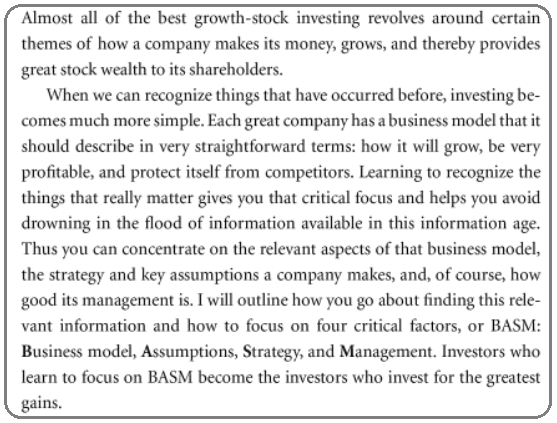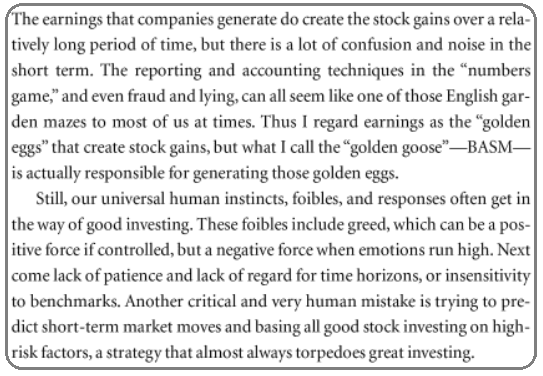Related Categories
Related Articles
Articles
Picking Great Growth Stocks ("BASM")
--------------------------------------------------------
Investing is actually common sense along with a focus on the key factors that drive the greatest stocks. In fact, investors need to focus on only four factors that seem to be...

...common, identifying traits of the greatest companies and stocks, following the experience of Fred Kobrick. Fred Kobrick has termed these four factors BASM (a) - (d):
♦ Business Model: How the company plans to grow, be profitable and protect itself from competitors.
♦ Assumptions: The key assumptions the company makes about their markets upon which they then develop the business model.
♦ Strategy: This is simply the plan the company develops to implement the business model.
♦ Management: These are the actual people who create the great business models, assumptions, execution and all the rest. Great management is also needed, over time, to adjust business models for competitive situations. One item not mentioned here is earnings. So, what about earnings, you ask?
Earnings are part of the metrics you use in evaluating a company-gross margin, net margin after taxes, and return on capital are just some examples of other metrics. These tell you a lot about the competitive position and how well the company is managed. But these are report-card issues. While you do learn something about management from them, the report card does not tell you about vision and fixing problems.
In short, earnings are the golden eggs that drive stock prices, but BASM is the golden goose that lays those golden eggs-it is the engine of earnings.
(a) The Business Model
The business model is the core of how a successful company operates. But most investors cannot tell you much or anything about their best investments and the business models. So let's start here-on the first big element in BASM.
A good company normally describes and discusses their business model in several places including what they file with the Securities and Exchange Commission when they go public or have successive stock offerings, and the annual reports, all of which are easy to access from the company and the Internet.
Here are the three elements of a strong business model:
1) The company describes how they are going to make a lot of money (or why they already are). If they are young and embryonic, they describe the specific path to get to great profitability.
2) The company describes how they will grow for a long time in the future, and how they will retain great profit margins and
overall profit growth.
3) The company describes how it will protect itself from the competitors that want to get a piece of their markets and profits. They must talk about competition and how they will compete, protect and win-in other words, how the first two things in the business model will stay that way and not fall prey to strong competitor companies that may come along.
One of the best examples of a great business model is Home Depot. When Home Depot came public, many people said it was just another big discount retailer. Many others challenged Bernie Marcus' (co-founder) plans to pay workers in his stores more and spend more than competitors on training. Bernie understood that discount retailing was going to be dog-eat-dog competitively, and yet there could be ways other than price to differentiate between companies.
The big thing for Home Depot was a business model that was designed to attract customers on the basis of customer service while being price competitive. Low prices often meant that people felt adrift and could not get enough help to purchase anywhere near what their potential might be.

(b) Assumptions
Any strategy that a company settles upon to achieve its business plan is built on a set of assumptions, or projections, about how big a market is for a company or a product. Assumptions also must be made concerning anticipated competition and demand over the next year or three years. The assumptions part of BASM is best illustrated with an example.
Bill Gates came into the software spreadsheet market facing skeptics who told him that, since Lotus Development had 70% of the spreadsheet market, he could do nothing, and it was already "game over." ("Game over" is one of the great syndromes of ordinary investing that ignores the elements of BASM.) So Lotus ran the hot product race without any real worries about Microsoft.
But Gates made huge assumptions about the way people and companies would buy and use software. His biggest assumption was that customers would have a critical need for standard software-in other words, consumers were looking for uniformity and continuity in software so they would not have to relearn everything from ground zero when new products came out.
Gates also assumed that consumers would stay with one company's products cycle after cycle if those products met their needs and were competitive in new technologies.
Setting standards and achieving early domination flowed from those assumptions as the core company strategy was formulated. Eventually, Lotus lost, and Microsoft (Fred Kobrick asks: "need I add?") won. Now it really is "game over."
(c) Strategy
Management may have a great business model, but it has to have a strategy to execute the details of its plans. Operational differentiation and excellence are concepts that apply to many great companies.
For instance, Intel has excelled over the years by continually coming out with the best new microprocessor chips to serve as the brains for personal computers. But aside from great product research and development, Intel spends a fortune on research and development in production methods and systems.
To reach back a bit further, McDonald's is one of the truly great companies. And it is clear the core secret to McDonald's great management success was operations. In fact, the McDonald’s business model went into great detail about how consistency and quality would flow from great operations management, and those factors would bring in the customers and control costs-and it did work, just as the company said.

(d) Management (NOBODY IS PERFECT)
The best management demonstrates that it can envision a great future for the company and articulate a cohesive and logical strategy for getting there. The strategy cannot be pie in the sky-it has to be based on resources-human, financial, technological-within the grasp of the company.
Management also has to show it can execute the details, so you must watch carefully.
Great managers make promises and projections to you, the stockholder, that they can deliver on. They are driven to stay ahead of the pack and understand how to lead. While they truly want to win, they are realists in terms of the goals they can execute. Lastly, great managers admit mistakes early and move aggressively to fix them.
-) Investing for the Big Money -(
Most investors spend too much time chasing the wrong information. Focus is the key, and the simplicity and focus of BASM really has worked to develop some of the greatest all-time investment records and wealth for many people. They do not always call it BASM, but they concentrate on what the golden goose is that creates the golden eggs of earnings.
REMARK:
-----------
This article was written by Fred Kobrick for the April 2007 issue of the AAII Journal.
Book / Text-source:
https://www.amazon.com/Big-Money-Picking



